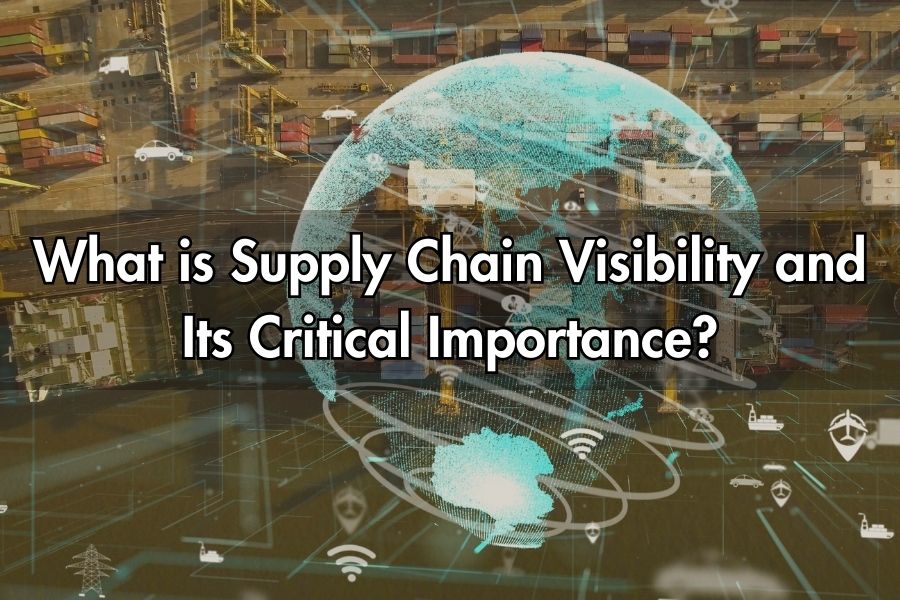Why Supply Chain Visibility is a Must-Have in 2025

What is Supply Chain Visibility and Its Critical Importance? Supply chain management is a critical element of modern business operations, ensuring goods and services move seamlessly from production to consumption. Within this framework, supply chain visibility (SCV) has emerged as a game-changer, helping organizations stay agile and competitive in an ever-changing global market. It is no longer just about moving goods; it’s about gaining real-time insight into every part of the process to make data-driven decisions and respond proactively to challenges. The importance of SCV has grown significantly with the increasing complexity of global supply chains. Businesses today face challenges such as fluctuating demand, geopolitical uncertainties, and the need to adapt quickly to changing market dynamics. Supply chain visibility not only helps businesses address these challenges but also creates a competitive edge by improving efficiency, reducing risks, and enhancing customer satisfaction. What is Supply Chain Visibility? Supply chain visibility refers to the ability to track, monitor, and manage the movement of goods, data, and resources across the entire supply chain. It involves integrating various technologies, processes, and systems to provide real-time, end-to-end insights into supply chain activities. In practical terms, SCV ensures that companies know the location and status of their goods at every stage—whether they are in production, transit, or storage. This visibility is crucial for identifying potential issues, optimizing workflows, and maintaining transparency with stakeholders, including suppliers, logistics providers, and customers. SCV goes beyond physical tracking. It includes financial transactions, inventory levels, and supplier performance metrics. For example, a retailer might use SCV to check stock levels in a warehouse, track incoming shipments from suppliers, and forecast demand for the upcoming season—all in real-time. The rise of digital technologies, such as IoT devices, blockchain, and AI, has made achieving supply chain visibility easier than ever. However, it also comes with challenges, such as data integration and managing the complexity of global supply chains, which businesses must address to unlock SCV’s full potential. Goals of Supply Chain Visibility The objectives of Supply Chain Visibility extend beyond simply tracking goods; they aim to create a responsive, efficient, and risk-resilient supply chain. Below are the primary goals of supply chain visibility: 1. Enhancing Transparency Transparency is the cornerstone of effective supply chain management. SCV ensures that all stakeholders, including suppliers, manufacturers, logistics providers, and customers, have access to accurate, real-time information. This transparency reduces misunderstandings, fosters trust, and facilitates seamless collaboration across the supply chain. 2. Optimizing Operations Visibility into every stage of the supply chain allows businesses to identify inefficiencies, such as delays in production, inventory mismanagement, or logistical bottlenecks. By addressing these issues promptly, companies can reduce costs, minimize waste, and streamline their operations. 3. Mitigating Risks Global supply chains are exposed to numerous risks, including natural disasters, geopolitical tensions, supplier failures, and demand fluctuations. SCV helps companies proactively identify these risks and implement contingency plans, ensuring business continuity. 4. Improving Decision-Making Supply chain visibility provides actionable insights that support data-driven decision-making. Whether it’s choosing a reliable supplier, optimizing inventory levels, or responding to market trends, SCV enables businesses to make informed choices. 5. Enhancing Customer Satisfaction Customers today expect greater transparency in their transactions, including updates on the status and location of their orders. SCV ensures that businesses can meet these expectations, leading to improved customer trust and loyalty. What Are the Problems and Solutions in Supply Chain Visibility? Achieving full visibility in supply chain operations is challenging due to various factors. Below are some common problems and their potential solutions: Supply Chain Visibility Problems Data Silos Different departments within an organization often use disconnected systems that do not communicate effectively. This fragmentation creates data silos, preventing the seamless flow of information across the supply chain. Lack of Standardization Inconsistencies in data formats and reporting methods among different suppliers, logistics providers, and partners make it difficult to integrate and analyze information. Complex Global Operations Managing a global supply chain involves dealing with diverse regulations, languages, currencies, and time zones. This complexity adds layers of difficulty to achieving end-to-end visibility. Limited Technology Adoption Many businesses, especially small and medium-sized enterprises (SMEs), lack access to advanced technologies such as IoT, blockchain, and predictive analytics, which are essential for SCV. Data Overload With the increasing use of IoT devices, sensors, and automated systems, companies generate vast amounts of data. Without the right tools and expertise, managing and analyzing this data can be overwhelming. Supply Chain Visibility Solutions Integrating Advanced Technologies Adopting technologies such as the Internet of Things (IoT), artificial intelligence (AI), blockchain, and machine learning can provide real-time insights and enhance data accuracy. IoT sensors, for instance, can track shipments, monitor inventory, and provide real-time updates on transportation. Using Cloud-Based Platforms Cloud technology facilitates seamless data sharing and collaboration among stakeholders, regardless of their location. It also supports scalability and ensures data security. Implementing Standardized Processes Developing standardized protocols for data collection, reporting, and analysis ensures consistency and simplifies integration across the supply chain. Leveraging Data Analytics Advanced analytics tools can process large volumes of data to uncover patterns, predict disruptions, and provide actionable insights. Predictive analytics, for example, can forecast demand fluctuations and help businesses plan accordingly. Building Strong Partnerships Collaboration with suppliers, logistics providers, and other partners ensures alignment and improves data sharing. Establishing clear communication channels and mutual trust is crucial for achieving visibility. What Are the Types of Supply Chain Visibility? Supply chain visibility encompasses various aspects of the supply chain, each contributing to a comprehensive understanding of operations. 1. Inventory Visibility Inventory visibility ensures that businesses can track stock levels across all locations, including warehouses, retail outlets, and in-transit shipments. This helps prevent overstocking, stockouts, and excessive carrying costs. 2. Transportation Visibility Transportation visibility focuses on monitoring the movement of goods in real-time. By tracking shipments, businesses can optimize delivery routes, reduce delays, and provide accurate delivery timelines to customers. 3. Order Visibility Order visibility allows both businesses and customers to track the status of orders, from placement to delivery. This transparency builds customer
